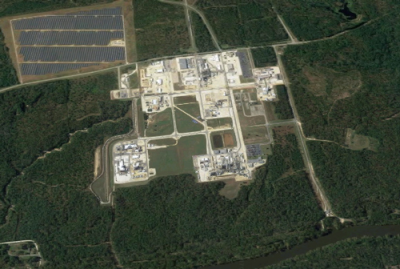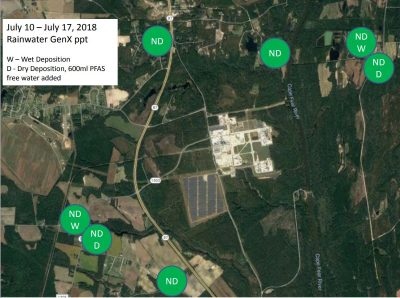North Carolina regulators have proposed that Chemours cut all GenX emissions at the Fayetteville Works facility by 97 percent by Friday, a feat the company insists is impossible short of shutting down the plant.

The North Carolina Department of Environmental Quality unveiled that deadline in June as part of a court order it said was under consideration and for which it sought public input. About 100 people responded by email, most of them expressing support for DEQ’s proposals or urging more stringent measures.
Supporter Spotlight
DEQ has not said whether it plans to proceed with the order. Questions submitted on Wednesday for this report went unanswered.
The proposed court order centers on the role Chemours’ air emissions play in fluorochemical contamination of groundwater, including about 160 private wells where tests have shown GenX at levels exceeding the state’s 140-parts-per-trillion provisional health goal.
GenX and other fluorochemicals also have been detected in a pocket of water beneath the 2,150-acre Fayetteville Works site, “contributing to contamination of groundwater (including off-site groundwater) and adjacent surface water bodies, including Willis Creek, the Georgia Branch and the Cape Fear River. According to Chemours’ analysis, flow of onsite groundwater directly to the Cape Fear River is the most significant current source of contaminant loading in the river,” the state wrote in the court order.
Chemours has announced a plan it says will cut sitewide emissions by more than 99 percent, once it is fully in place at the end of next year. In the meantime, interim abatement measures have performed beyond expectations, the company has said, though reductions achieved so far fall significantly short of what would be needed today should the state make its demand official.The company also has charged that the 97 percent reduction is “not based on a claimed public health need.”
Supporter Spotlight
Instead, Chemours contends, that’s the emissions reduction believed necessary to prevent additional GenX groundwater contamination greater than 10 ppt.
That 10 ppt level is the smallest concentration that can reliably be measured: the practical quantitation limit, or PQL. Because no groundwater standards exist for GenX, under state law any amount at or above the PQL is a potential violation. Chemours learned that last September when DEQ issued its first notice of violation against the company after GenX and other fluorochemicals turned up in water samples drawn from monitoring wells at Fayetteville Works. Subsequent notices of violation also cited the PQL provision.
Chemours hopes to remedy that situation through an application submitted to DEQ in April to establish an interim groundwater standard for GenX of 70,000 ppt.
Regulators Focus on Air Emissions
DEQ’s efforts to address Chemours’ GenX-related pollution began in June 2017, concentrating on pollutant-laden wastewater discharged to the Cape Fear River. By November, DEQ had suspended Chemours’ discharge privileges, and the company began capturing all of its wastewater and trucking it to Texas for disposal. Discharges have continued from two other companies at the site: DuPont and Kuraray.
In an Aug. 3 conference call to discuss quarterly earnings, Chemours CEO Mark Vergnano told analysts the company expects to spend $35 million this year “related to process water treatment at our Fayetteville facility, in addition to associated remediation and legal costs.”
A few months into their investigation, regulators’ attention had begun to turn to groundwater, first in monitoring wells at the Fayetteville Works and eventually private wells in an expanding radius around it. At least some level of GenX has been found in more than 500 wells.
That led regulators to begin eyeing the company’s air emissions, from what comes out of stacks to leaks in equipment.Chemours initially estimated its GenX emissions totaled about 66.6 pounds per year, but subsequent estimates steadily increased.
“Current data, as reported by Chemours, indicates that Chemours emitted approximately 2,199 pounds of GenX compounds in 2017,” according to the state.
To better understand the extent of contamination from Chemours’ airborne fluorochemicals, DEQ tested rain. For example, among a number of samples gathered between Feb. 28 and March 2, one taken 5 miles northeast of the plant showed GenX at 810 ppt.
On April 6, DEQ’s Division of Air Quality gave Chemours 60 days’ notice that the state intended to modify its air permit. State regulators wrote they “had no knowledge that Chemours was emitting GenX at current rates reported by Chemours” in December 2016 when they issued the company’s air quality permit.
DEQ offered Chemours two options to resolve the situation: Demonstrate that current GenX air emissions do not contribute to groundwater contamination or come up with a plan that persuades the state emissions will be slashed to a level that won’t pollute groundwater.
Will Wells Ever Be PFAS Free?
A few weeks following that notice, Chemours outlined a $100 million pollution-abatement plan. Interim measures include two carbon adsorption units completed in May and upgrades to scrubbers expected in October.
Ultimately, Chemours plans to have a thermal oxidizer, generating tremendous heat to pry apart fluorochemicals’ stubborn chemical bonds. Assuming construction starts Oct. 1 as planned, the thermal oxidizer will start up by the end of 2019. Altogether, the company has said, its efforts will reduce emissions to a comparative trickle, less than 1 percent of 2017 levels.
Already, early signs indicate its efforts may be making a difference.
“We have submitted monthly status reports to the DEQ, which do show we have achieved better emissions reduction results with our carbon adsorption beds than initially anticipated by this point in time,” Chemours spokeswoman Lisa Randall said Wednesday.

Concentrations of GenX measured in rain appear to be diminishing, recently to undetectable levels, a trend regulators mentioned in August during a community meeting on fluorochemicals in Fayetteville organized by the U.S. Environmental Protection Agency.
“Based on what DEQ presented at the EPA listening session, it sounded to me like the current abatement of air emissions with GAC is achieving greater reductions than anticipated and that GenX levels in rain were non-detect after the GAC was installed,” said Detlef Knappe, a professor at North Carolina State University and a leading researcher on fluorochemicals in water. “In a way that’s not surprising, because early on in the GAC service life, PFAS are effectively removed. The question is, for how long?”
GAC, or granular activated carbon, is the filter media in Chemours’ carbon adsorption units. PFAS is an acronym for per- and polyfluoroalkyl substances, the class of chemicals that includes GenX and the other fluorochemicals in pollution from Chemours.
Even assuming emissions continue to drop, though, it’s unclear how long wells will remain tainted. For those with wells having GenX concentrations exceeding 140 ppt, Chemours is offering to install GAC filters.
In an interview earlier this summer, Fayetteville Works plant manager Brian D. Long said: “I’m not able to really articulate” when contaminated wells will be free of GenX.
“You know, the fluorine molecule is a pretty tough molecule, and it’s a compound that does persist in the environment. Over time, as the water is drawn out of those wells through the GAC unit, it (GenX) is going to be removed. Maybe it’s a function of how much water is pulled through that. I don’t know how long it’s going to stay.”
Chemours Seeks GenX Groundwater Standard
On a related front, Chemours petitioned DEQ in April to establish an interim maximum allowable concentration, or IMAC, for GenX in groundwater. The company suggests an IMAC of 70,000 ppt, using essentially the same reasoning that last week failed to persuade the state’s Science Advisory Board to recommend changing the state’s 140 ppt health advisory for drinking water.
IMACs establish potentially enforceable concentrations in North Carolina groundwater for substances not covered by government rules. DEQ lists 60 IMACs in a file (Microsoft Word document) on its website.
DEQ did not respond to questions regarding the status of Chemours’ petition, and Chemours said it was unaware of any change.







